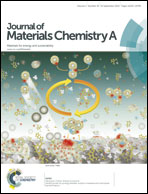A free-standing, flexible lithium-ion anode formed from an air-dried slurry cast of high tap density SnO2, CMC polymer binder and Super-P Li†
Abstract
A free-standing electrode film composed of high tap density SnO2 particles and carboxymethyl cellulose binder with Super-P Li (SP-Li) conductive carbon was formed from an aqueous slurry cast by doctor-blading. Upon air-drying, the free-standing film spontaneously evolved via delamination from the substrate as the slurry solvent evaporated. The electrodes cut from the free-standing film were ∼5 μm thick with a SnO2 loading of ∼0.5 mg cm−2. The films were found to be easily handled, flexed and folded. For evaluation of the durability of the free-standing films, the tensile strength and elongation at break were measured: 13 MPa and 1.7%. The robustness of the electrically conductive network was measured with a four-point probe: the initial electrical resistivity of the film (0.6 Ω cm) was observed to increase by 6% after folding, applying pressure to the crease and unfolding. When tested in a coin cell, the electrode cycled stably with near 100% coulombic efficiency at up to 2 C and without capacity fade for 100 cycles at 1 C. To adjust the areal capacity of the cell, multiple free-standing films could be stacked. An electrode formed from several stacked films with an active material mass loading of greater than 4 mg cm−2 was found to cycle stably at 2.6 mA h cm−2 tested at 0.33 mA cm−2 current density. For evaluating cycling performance of the electrode while flexed, an electrode was placed in a once-folded pouch cell for testing at 1 C and cycled stably for 20 cycles before slight capacity fade was observed. For free-standing electrodes, 1D or 2D carbons such as carbon nanotubes (CNT) or graphene are commonly used to provide both mechanical strength and electrical conductivity. Here, CNTs were substituted for the SP-Li and similar free-standing films were made and compared. With CNT, the electrode strength at break as well as the electronic conductivity increased, but, despite this, the cycling performance of the electrodes made using the low-cost SP-Li carbon exceeds that of the electrodes made with orders-of-magnitude more expensive 1D carbon.


 Please wait while we load your content...
Please wait while we load your content...